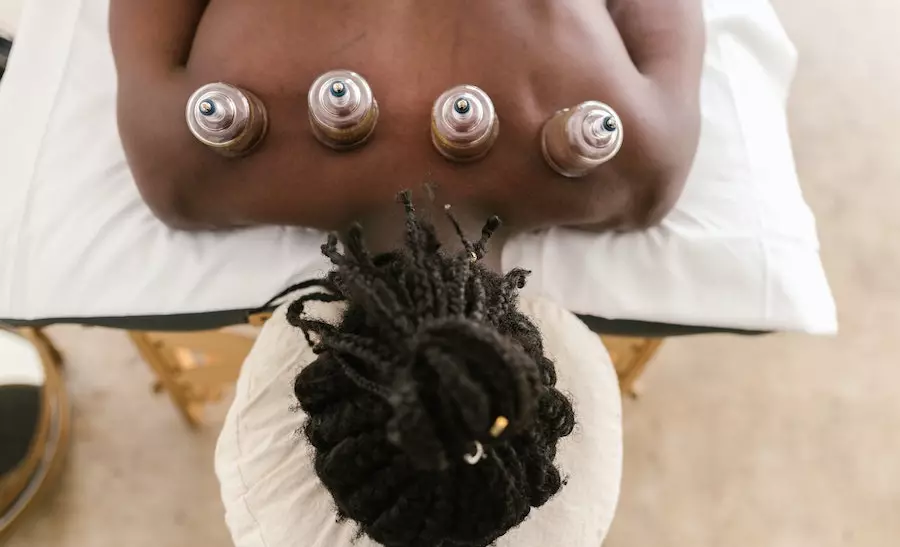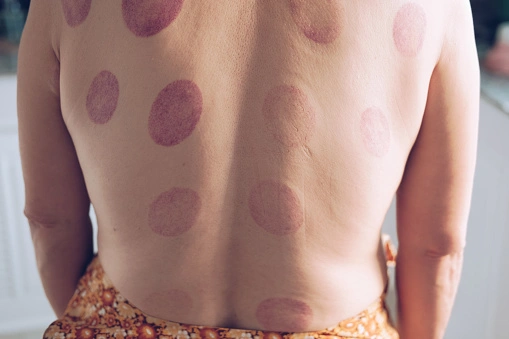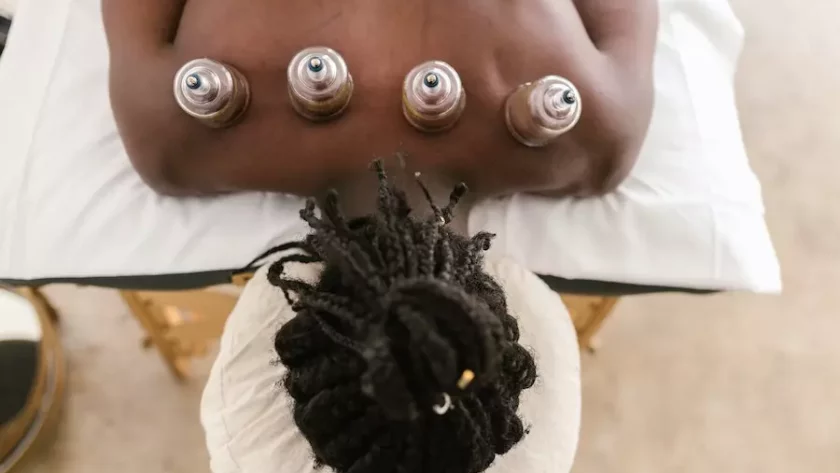What Is Cupping Therapy?
Contents
Cupping therapy is an ancient form of alternative medicine that involves placing a cup on the skin using the form of suction.
It was first documented on Eber’s papyrus 1550 BCE early, where a cup was mentioned in Ancient Egypt.
Also mentioned in Asia, animals’ horns, which would have been used to drain fluid from the body.
In modern times, it is going on trending, due to its multiple health benefits, and with fewer side effects.
It has many purposes include – improve blood circulation, treating respiratory diseases, such as:
The cups are made up of:
- Plastic
- Bamboo
- Silicone
- Glass
- Earthenware
- Bronze
- Animal horn (was likely first used in ancient times)
In modern cupping therapy, specialists use a rubber pump instead to fire to create the vaccine inside the cup.
Many cupping therapists scientists claim it’s an effective pain reliever, which also improves overall wellbeing and energy levels (1)

2. How Does It Work?
NOTE: In both types of cupping, the therapist will put flammable substances such as alcohol, herbs, and paper in a cup and set it on fire, which creates suction.
Line-wise steps have been given here so that you will understand well.
- Suction: In this phase, the therapist found specific points for cupping and disinfecting the area. Now the therapist creates suction inside the cup with flame and vacuum.
- Needle prick: It depends on which type you choose – dry or wet, In wet, the therapist uses a needle to remove blood on the cupping area.
- Suction and bloodletting: With dry cupping, the cup is kept about for 5 to 10 minutes. In wet cup is removed after 8 to 10 minutes of bleeding.
- Removing the cup: Now, the therapist removes the cup, gently.
- Dressing: Now, dressing that area after cleaning and disinfection. And suitable size strips were applied to the affected area, which remains around 48 hours.
Cupping is used on the back, abdomen, neck, chest, shoulders, buttocks, and other musculoskeletal conditions.
NOTE: The residual marks left from cupping disappear in 1-10 days.
3. Types
There are many types of cupping therapy, however, dry and wet cupping are the two main types.
Dry cupping
For dry cupping, using fire to create a suction is the most popular choice and the primary method used in China (2)
A suction method only means – no bleeding.
In dry cups apply heated cups on the skin include – back, chest, abdomen, or buttocks.
Your skin may turn red as the blood vessels respond to the change in pressure in dry cupping.
Wet cupping
Traditional, wet cupping is commonly used in China, Korea, and Germany (3)
Wet cupping is also known as ‘Hijama‘ or medical bleeding, In the skin is lacerated so that blood is drawn into the cup.
Running cupping
In this, therapists use silicone cups, where suction cups are moved over your skin from one place to another for a massage-like effect.
4. Benefits
Both healthy people and those suffering from any problem or ailments can take it. and it
Cupping therapy has been used for centuries to treat a wide variety of health disorders, which has many health benefits. which include:
- Relieve headache – In one study, cupping therpay decreased by 12.6 days per month in patients with a headache.
- Low back pain
- knee pain (4)
- Dry cupping has shown benefit to patients suffering from chronic back pain and neck region of the spine.
- Recovery injury
- Restored neuroendocrine cells, that mainly found in small intestine, pancreas, and lungs bronchioles.
- Increase flexibility
- A research shown that cupping therapy Improve blood circulation and remove toxins waste that trapped in tissue.
- Tissue perfusion
- Improve oxygen supply (5)
It is also believed that cupping stimulates pain receptors which leads to an increase in the frequency of impulses, resulting, leading to the closure of the pain gates and pain reduction (6).
German study traditional, shown that wet cupping was effective in treating numbness, tingling, or weakness in your hand.
Also, it has shown effective against cough, acne, and dyspnea (shortness of breath) (7)
Systemic illnesses (that affect the entire body) people can see their benefits. person includes:
- Diabetes person
- Skin disorder
- High blood pressure
- Arthritis
- Mental disorder
These Cups also help in decreasing cellulite. And cosmetic cupping services are available in India.
5. Who should avoid cupping therapy?
Cupping therapy isn’t recommended for everyone. If you fall into this category, it would be good to avoid cupping therapy are:
- Pregnant women, and during period time women not recommended cupping therapy.
- Under 18 years old and older people
- High cholesterol people, are at a higher risk of heart disease with cupping. (8)
- Chronic diseases
- Deep vein thrombosis (DVT), happen when a blood clot forms in one or more of the deep veins in your body, usually in your legs.
- Cupping done over damage, oozing, or infected areas may cause an increase in D-dimer levels.
- Cardiovascular disease
- Open wound and bone fracture people should avoid this (9)
- Person who are being treated with anticoagulant (a medicine that help prevent blood clots) should avoid it.
- Acute infection people, should generally avoid cupping therapy
6. Additional Points
If we talk about its price – then it can go from 500 to 5000, 7000 Rs thousand in India.
Should not be done directly over nerves, arteries, eyes, skin inflammation, an open hole like nostril, mouth, or areas with skin inflammation (10)
Frequency of therapy: every 10 to 15 days.
7. Scars After Cupping therapy

8. How to do it at home?
Physiotherapists used to make maximum use of it, but modern time fitness training industry used a lot as well.
It is quite easy to take, that is why it became so popular in a short period of time.
2 things you need for this – cups and a suction gun (which you can buy from any shopping platform).
Step 1 – place cup on muscle, not around bones.
Step 2 – Create suction with a gun (three types of suction -half pull, full pull, and 2 to 3 times pull)
Step 3 – Keep it for 10 to 20 minutes, if skin color redness, then there is a need to remove it a little.
Step 4 – Press noob and remove it.
9. Side Effects
Cupping therapy is considered quite safe, as long as you go to a trained health specialist.
However, some side effects are seen at the place of keeping the cup. But these can be preventable adverse effects are:
- Mild discomfort, especially during sleeping
- skin infection
- Itchy skin
- Anemia
- Scar formation
- Abscess is a painful collection of pus
- Painful bumps
- Burns, if fire is used for suction, then obviously a burning sensation, and bumps will be felt.
non-preventable side effects include:
- Headache
- Tiredness
- Dizziness
- Nausea
- Insomnia
- Redness of the skin, and discoloartion under the skin, which commonly seen in dry cupping.
- Scarring, and feeling sudden drop in blood pressure, can seen in wet cupping.
If you experience or face any other discomfort, consult your therapist, they offer you some remedies to avoid any discomfort, and you can tell your doctor.
NOTE: Get therapy done only by a specialist, If the cup is contaminated with blood, it may cause bloodborne diseases such as hepatitis, HIV, etc.
BOTTOM LINE
Cupping therapy has many benefits including blood circulation, treating respiratory diseases, reducing pain, providing deep-tissue massage, etc
It is used on the back, abdomen, neck, chest, shoulders, buttocks, and other musculoskeletal conditions.
Should not be done directly over nerves, arteries, eyes, skin inflammation, an open hole like nostril, mouth, or areas with skin inflammation.




